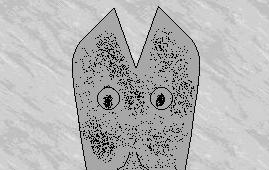They say that we make fun of what we fear the most. (I refer, of course, to the Department of They, the 1200 person, quasi-official federal agency that was given a mandate by Parliament to create aphorisms for people without the confidence or imagination to create their own.)
Laughter is a form of emotional purgation. Thus, making light of an otherwise scary idea makes it easier for a person to deal with. In semidiotics, the science of sense in nonsense, this observation is referred to as The Boothought Principle.
A boothought is an idea which causes anxiety. (The etymology of the word refers to a thought which jumps out at you from the dark when you’re lying in bed late at night and shouts, “Boo!”) By referring to ideas as boothoughts (as opposed to “things that scare the pants off us”), it is suggested that we can better cope with our fears.
Semidioticians have determined that there are two dimensions to boothoughts, often referred to as intensity and personality. Intensity indicates how deeply affecting the boothought is. Personality refers to how directly the boothought affects a person’s life.
Boothought intensity is usually measured on a six point scale. Miroscary boothoughts are not very intense at all, practically drifting towards the yaythought scale (yaythoughts are the positive correlative of boothoughts, a further discussion of which is forthcoming in the Journal of Everyday Semidiotics). At the other end of the scale, megascary boothoughts are deeply felt, intense statements of a person’s darkest fears (see Chart 1).
| MICROSCARY | laughing out of context |
| MINISCARY | lack of personal freshness |
| SCARY | not being able to make car insurance premiums |
| BIGSCARY | your children rejecting all your values |
| MAXISCARY | complete financial ruin |
| MEGASCARY | death |
CHART 1
Intensity Boothought Scale (Personal) and Examples
Boothought personality is also measured on a six point scale. Personal boothoughts are those which involve a person directly. On the other hand, global boothoughts are concerned with more wide-ranging issues (see Chart 2). It would be a mistake to assume that, as personality becomes more distant, intensity decreases; the two are not directly related, as Keaton’s experiments with lab assistants clearly demonstrated.
It must be pointed out that these divisions are arbitrary, that boothoughts aren’t really so easily categorized. Indeed, many revisionist semidioticians have suggested changing the scales, or measuring totally different properties. (This is in keeping with Halberstam’s Axiom that when scientists have exhausted a line of investigation, they change their terms in order to milk the subject for additional publishable papers.)
This culminated in a massive letter writing campaign to the Journal of Scientific Esoterica in 1982 over the question of whether the personality scale should include a seventh level, tentatively called “universal.” The results were typically inconclusive: the general feeling was that universal was a legitimate designation; however, inasmuch as the only boothought at that level that anybody could think of was heat death, and that wasn’t uppermost in most people’s minds, the whole argument was discounted as frivolous.
| PERSONAL | your slip is showing |
| FAMILY | your child gets a C- in algebra |
| NEIGHBOURHOOD | somebody’s dog is loose again |
| COUNTRY | the Minister of Car repossession resigned |
| CONTINENTAL | the temperature dropped half a degree yesterday |
| GLOBAL | Canada and Albania are having an arms control summit |
CHART 2
Personality Boothought Scale (Miniscary) and Examples
It is at this point that most theorists usually consider the practical applications of The Boothought Principle. It is recognized that individual boothoughts are rarely the cause of major personality disorders, no matter how intense. Pathological behaviour is most often associated with boothought clusters, the rapid procession of several, often related boothoughts.
One often cited case is of a woman in Moline who, for no readily apparent reason, bought 12 crates of Liquid Plumber, abandoned her family and moved to Natchez, where she became a moderately successful morning weather announcer for a local radio station. Subsequent intensive boothought therapy pinpointed her many fears, which included: snakes, spiders and being trapped in an enclosed space with Alex Trebek.
(Boothought therapy, although still in its infancy, involves many intense sessions where an individual’s boothoughts are brought out into the open and relentlessly made fun of. Traditional therapists remain skeptical, although the most recent literature suggests that some are beginning to take it less seriously.)
The Boothought Principle has a wide variety of other applications, but there isn’t enough space to go into them here. Besides, I’ve got to publish more papers if I ever hope to achieve tenure!


